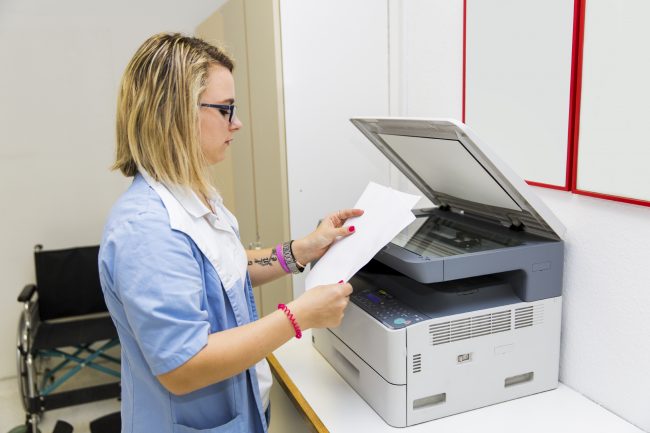The health and social care sector is facing a bit of a fax machine crisis. In the UK, the NHS is reliant on the technology, with over 9,000 units still in use across the country. The result is that many other businesses and practices — such as those working in dentistry, pharma, private healthcare, etc. — are required to use fax machines as well.
But now, the tides are turning against the fax machine.
Matt Hancock, Healthcare Secretary, has labelled the technology “downright dangerous”, while the government has given the NHS a deadline of March 2020 to eliminate the use of fax machines entirely. As of January 2019, the NHS is banned from purchasing new machines. But what does this mean for the health and social care sector as an industry?
The fax machine is entrenched within the sector — but for good reason. Without the ability to fax, those operating within healthcare lose the ability to immediately send and receive files and records, as well as share signed documentation such as prescriptions and order forms.
In the wake of the announcement to remove fax machines from the healthcare sector, many practices and trusts have come out in support of the “axe the fax” movement. Yet removal of fax machines does create a problem. Why? Because it’s a significant factor in health and social care communication, which means an alternative is required.
The Problem with Axing the Fax
Right now, the fax machine, as outdated as it may be, provides the healthcare sector with a universal method of file and data transmission, and benefits it cannot get from other mediums. With such heavy reliance on the units, near every business, trust, practice or care service will be using fax machines as a form of document sharing, which means no matter what you do within the healthcare sector, files can be shared effectively.
Elimination of the fax machine, though, has the potential to erode this type of universal communication platform. Alternatives must be found to replace the technology. The issue here is that alternatives may not be adopted in the same widespread manner that the fax machine currently is.
Conventional wisdom suggests emails are the answer, but its weaknesses in terms of data security and functionality limitations may lead some organisations to different technology. Others in healthcare, such as those not forced to remove fax machines entirely, may also insist on continued usage of the technology. For example, firms that work in pharmaceuticals require high levels of legal protection, which fax machines can provide — both in terms of legally binding signature transmission and accurately time-stamped files that are admissible in legal procedures.
Coordination has never been a strong point of the healthcare industry, and now that the sector is being forced to move away from a system that provides it with comprehensive communication coverage, the potential for problems is very real.
The Solution to the Fax Problem
Fax machines already have one foot out the door. As NHS Digital pushes for Paperless 2020 and the government further pushes the industry by forcing fax machine use to be discarded entirely, there is no escaping the fact that you’ll need to make a change if you want to continue working effectively within health and social care.
An alternative is required, but what is the optimum solution? The answer is cloud faxing.
Cloud faxing is not new technology, in fact, it’s been adopted by over half of all fortune 500 companies. The popularity of the platform is derived from the numerous advantages it has over other methods of communication, such as using a fax machine and email.
Cloud faxing allows for the continued transference of visual files in a quick and timely manner, which is of critical importance in healthcare, while also enabling the submission of signatures and accurate timestamps for better legal protection. In terms of improvements, it bolsters security through higher levels of security than those of both fax machines and emails, and enables more diverse options for document sharing at the same time.
Online cloud faxing is essentially the evolution of fax technology. Moved into the modern era, it provides all the functionality of faxing but through a digital platform. Files aren’t transmitted through fax machines but, instead, computers, applications and online portals. This creates more effective and efficient processes while still allowing you to continue to send fax online.
Why Cloud Faxing Is the Answer for Your Healthcare Organisation
So what are the problems with removing the fax machine from the healthcare sector?
- Essential functionality is lost
- Universal communication is lost, too.
But it has to go.
Fax machines create inefficiencies in workflow and security nightmares, as highlighted by cognitive behavioural therapist Rebecca McIntyre, who stated that fax machines are “a continued risk to the confidentiality and safeguarding of patients. We constantly receive faxes meant for other places in error, but this is never reported.“
Cloud faxing helps to alleviate some of the inefficiencies and security concerns of physical faxing while allowing for the continued functionality required of many healthcare organisations.
What’s more is that online faxing enables fax documents to be shared with both email addresses and fax machines, helping you to achieve a universal communication platform, no matter what other practices, trusts, firms and organisations decide to do following the demise of fax machines in healthcare.












